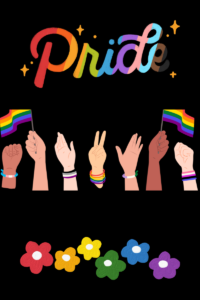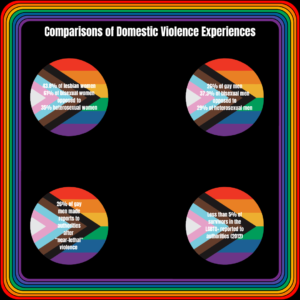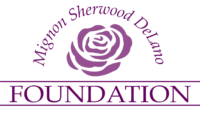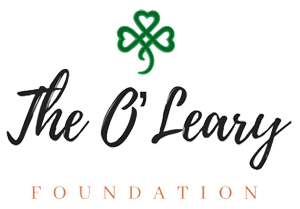- Arlana
- Jun, 17, 2024
- Blog
- Comments Off on Putting It Off Makes It More Apparent: LGBTQ+ Domestic Violence
Putting It Off Makes It More Apparent: LGBTQ+ Domestic Violence

June is pride month for the Lesbian, Gay, Bisexual, Transgender, and Queer (LGBTQ+) community in America. Joint Base Andrews states, "The federal government first recognized the month in 1999 when President Bill Clinton declared June 'Gay & Lesbian Pride Month.' In 2009, President Barack Obama declared June LGBT Pride Month. On 1 June 2021, President Joe Biden declared June LGBTQ Pride Month" (2023). These statements prove evolution for the community. However, severe issues, such as domestic violence is historically disregarded by society, state, and federal government.
Statistics
According to the National Coalition Against Domestic Violence Organization (NCADV), people in the LGBTQ+ community are mostly excluded from the domestic violence movement. This is because society, state, and federal government traditionally focused more on heterosexual relationships (2018). Statistics are tricky because a lot of cases are not reported. However, in 2018, the NCADV disclosed equal to greater percentages of LGBTQ+ members falling victim to domestic violence compared to heterosexual couples (2018).

Many forms of abuse are apparent in the statistics above. Violence is not limited to being sexually and physically abused; threats, insults, and stalking also fall into the category. Moreover, it is vital to mention that the LGBTQ+ community is a broad spectrum. This prior research may be outdated, but it is necessary to share. It showcases the need for more awareness. More stories need to be shared! More aid needs to be given!
Intersectionality and intersectional identities are within the LGBTQ+ community. Therefore, outside of being queer, Asians, Black and African Americans, Indigenous Persons, Latinos, and any other group that does not fit into the set standard, bear the inequity of more oppression. Black and African American victims are more prone to physical violence than other races and ethnicities. Transgender victims are more likely to be abused publicly as opposed to non-transgender persons. Bisexual victims are more likely to be sexually abused than non-bisexuals. Additionally, white victims are inclined to be sexually abused more than others in the community who do not identify as white. These statistics are real examples, but should not be limited to others that are not reported.
Treacherous Obstacles to Receive Help
The NCADV and the Women Advocates organization discuss several barriers the LGBTQ+ community experiences when seeking help. To reiterate, domestic violence is heavily portrayed as only a heterosexual problem. Homophobia, transphobia, and queerphobia are still apparent because they are minorities. Some fear they will be judged and mocked by service providers and non-LGBTQ+ domestic violence victims. "Will I be outed?" is a troubling concern. Some believe spreading awareness may detract from the community's societal progress. Lastly, being judged and hated for merely being who they are can diminish their confidence.
Federal and State Action
In 1994, the Violence Against Women Act (VAWA) was passed to protect women from domestic violence; however, the federal government amended the act for LGBTQ+ victims (Samons, 2013). In 2013, VAWA was reauthorized for the third time, and made "major" advances to protect heterosexual and same-sex relationships, transgender people, illegal immigrants, and Native American women (Samons, 2013). Christina Samons explicitly provides examples from the act in "Same-Sex Domestic Violence: The Need for Affirmative Legal Protections at all Levels of Government. The original version of the act was vague and left room to exclude the community. Fortunately, President Barack Obama and his administration released an "official opinion" that broadly included everyone in 2010. The reauthorization debate was set in 2012 without progress until the next year.
The federal government made vital changes, but crime will not decrease if the state government does not follow suit. We can see the differences in application or requirements across different states. Generally, states protect families and criminal law statutes from domestic violence, and victims must fit the requirements to obtain a protection order (PPO). California and Hawaii are examples of inclusivity in the state. A person does not need to press charges for a protection order in California. Domestic violence statutes in Hawaii protect LGBTQ+ victims. However, minors (anyone under the age of 18) can only obtain a protection order if a family member or guardian applies for them.
In contrast to these more inclusive and progressive measures, Samons provides information about New York. Same-sex domestic violence is not a crime if the people involved are not family members despite having the largest population of same-sex couples almost 24 years ago. Samons states, "According to the New York Family Court Act of 2002, a domestic violence victim could petition for a protective order for crimes like assault and harassment" (Samons, 2013). The act benefited some same-sex relationships, but the violence had to fit under the umbrella; there were too many limitations.
Summary
- Domestic violence does not only affect heterosexual relationships.
- LGBTQ+ members are more likely to fall victim to domestic violence than heterosexual persons.
- The LGBTQ+ community has a broad spectrum, and statistics do not show that.
- The LGBTQ+ community is a minority and has subminorities.
- The LGBTQ+ community has many barriers when seeking and receiving aid.
- The federal government has acted more than the state government. Crime will not decrease because of it.
References
Sylvia’s Blog
- VAWA and VOCA at Sylvia’s Place December 9, 2024
- Comorbid Dangers: Financial Abuse November 4, 2024
- Comorbid Dangers: Domestic Violence & Animal Abuse September 16, 2024





